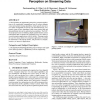Free Online Productivity Tools
i2Speak
i2Symbol
i2OCR
iTex2Img
iWeb2Print
iWeb2Shot
i2Type
iPdf2Split
iPdf2Merge
i2Bopomofo
i2Arabic
i2Style
i2Image
i2PDF
iLatex2Rtf
Sci2ools
106
Voted
NOSSDAV
2009
Springer
2009
Springer
SLIPstream: scalable low-latency interactive perception on streaming data
A critical problem in implementing interactive perception applications is the considerable computational cost of current computer vision and machine learning algorithms, which typically run one to two orders of magnitude too slowly to be used interactively. Fortunately, many of these algorithms exhibit coarse-grained task and data parallelism that can be exploited across machines. The SLIPstream project focuses on building a highly-parallel runtime system called Sprout that can harness the computing power of a cluster to execute perception applications with low latency. This paper makes the case for using clusters for perception applications, describes the architecture of the Sprout runtime, and presents two computeintensive yet interactive applications. Categories and Subject Descriptors C.3 [Computer Systems Organization]: Special-Purpose and Application-Based Systems; D.2 [Software]: Software Engineering General Terms Algorithms Design Performance Keywords Parallel Computing, Clust...
Considerable Computational Cost | Interactive Perception Applications | NOSSDAV 2009 | Operating System | Perception Applications |
| Added | 27 May 2010 |
| Updated | 27 May 2010 |
| Type | Conference |
| Year | 2009 |
| Where | NOSSDAV |
| Authors | Padmanabhan Pillai, Lily B. Mummert, Steven W. Schlosser, Rahul Sukthankar, Casey Helfrich |
Comments (0)

